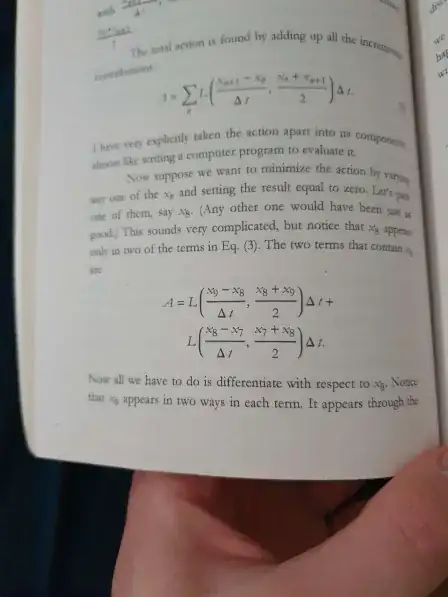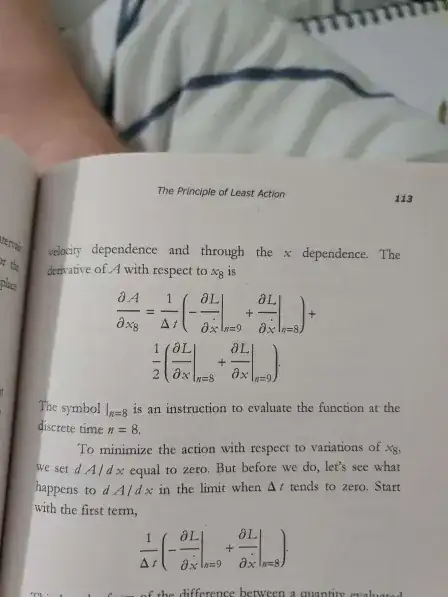The author is demonstrating how you might derive the Euler-Lagrange equation by minimising the action at a certain point. He substitutes a point $x_8$ into the lagrangian and then differentiates the action with respect to $x_8$. I can't understand how this is done.
1 Answers
The book you are showing pictures of is 'The theoretical Minimum', by Leonard Susskind and George Hrabobsky.
The book is based on the series of lectures by Susskind on classical mechanice; Hrabovskiy reworked the content to bookform.
Deriving the Euler-Lagrange equation in that way is possible, but my impression is that the execution by Susskind and Hrabovsky is not up to scratch.
I recommend that you skip the derivation by Susskind and Hrabosky, and that instead you absorb the following derivation by Preetum Nakkiran:
Geometric derivation of the Euler-Lagrange equation
The underlying idea of that approach to deriving the Euler-Lagrange equation is described in an answer I posted in 2021, about Hamilton's stationary action
The total time interval is divided in equal sub-intervals.
For the derivation the sub-intervals are grouped in pairs, described by a trio of three consequtive points, in the following pattern:
$t_1, t_2, t_3$
$t_2, t_3, t_4$
$t_3, t_4, t_5$
And so on, until the last point of the total time interval.
The derivation is set up such that is generic for any trio out of the sets in the total time interval. That means that the resulting relation is valid for all points along the total time interval concurrently. The derivation is not for a single point; it is for all points along the total interval concurrently.
The finalizing step is analogous to the finalizing step of differential calculus: the expression is taken to the limit of subdivision into infintitesimally small subsections.
The point is: the Euler-Lagrange equation is a differential equation. The usual approach is to derive it by application of integration by parts. But the end result of that process is a differential equation, therefore it must be posssible to derive the Euler-Lagrange equation using differential reasoning only. And indeed that is the case: the Euler-Lagrange equation can be derived using differential reasoning only.
Let me address the following:
why do I think the derivation by Susskind and Hrabovski is not up to standards?
Some months ago, on another forum, I answered a question about that derivation. That question was very specific: a mismatch between two equations that were supposed to be consequtive steps in the derivation.
I wrote there:
Very often when an author is trying to work out a derivation the author is working from both ends. That is, the author is also taking the goal of the intended derivation, working back from that to what the derivation is supposed to be starting from.
Metaphorically: when a tunnel is dug the work is started from both ends, and beforehand you don't know which side will progress the fastest. You don't know beforehand where you will meet.
My best guess is that the transition you are asking about is where Susskind and Hrabovsky had to figure out how to make ends meet, coming in from opposite directions. Well, there's a gap.
I'm not motivated to go back into the book. That is why I recommend the derivation by Preetum Nakkiran.
- 24,617

